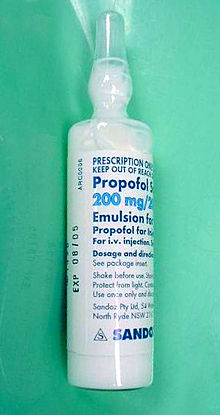Emulsion

An emulsion (IPA: /ɪˈmʌlʃən/[1]) is a mixture of two immiscible (unblendable) substances. One substance (the dispersed phase) is dispersed in the other (the continuous phase). Examples of emulsions include butter and margarine, milk and cream, espresso, mayonnaise, the photo-sensitive side of photographic film, magmas and cutting fluid for metal working. In butter and margarine, oil surrounds droplets of water (a water-in-oil emulsion). In milk and cream, water surrounds droplets of oil (an oil-in-water emulsion). In certain types of magma, globules of liquid NiFe may be dispersed within a continuous phase of liquid silicates. Emulsification is the process by which emulsions are prepared.
Emulsion is also a term used in the oil field as untreated well production that consists primarily of crude oil and water.
Operation
Emulsions tend to have a cloudy appearance, because the many phase interfaces (the boundary between the phases is called the interface) scatter light that passes through the emulsion. Emulsions are unstable and thus do not form spontaneously. Energy input through shaking, stirring, homogenizers, or spray processes are needed to form an emulsion. Over time, emulsions tend to revert to the stable state of the phases comprising the emulsion. Surface active substances (surfactants) can increase the kinetic stability of emulsions greatly so that, once formed, the emulsion does not change significantly over years of storage. Homemade oil and vinegar salad dressing is an example of an unstable emulsion that will quickly separate unless shaken continuously. This phenomenon is called coalescence, and happens when small droplets recombine to form bigger ones. Fluid emulsions can also suffer from creaming, the migration of one of the substances to the top of the emulsion under the influence of buoyancy or centripetal force when a centrifuge is used.
Emulsions are part of a more general class of two-phase systems of matter called colloids. Although the terms colloid and emulsion are sometimes used interchangeably, emulsion tends to imply that both the dispersed and the continuous phase are liquid.
There are three types of emulsion instability: flocculation, where the particles form clumps; creaming, where the particles concentrate towards the surface (or bottom, depending on the relative density of the two phases) of the mixture while staying separated; and breaking and coalescence where the particles coalesce and form a layer of liquid.
Whether an emulsion turns into a water-in-oil emulsion or an oil-in-water emulsion depends on the volume fraction of both phases and on the type of emulsifier. Generally, the Bancroft rule applies: emulsifiers and emulsifying particles tend to promote dispersion of the phase in which they do not dissolve very well; for example, proteins dissolve better in water than in oil and so tend to form oil-in-water emulsions (that is they promote the dispersion of oil droplets throughout a continuous phase of water).
Emulsifier
An emulsifier (also known as an emulgent) is a substance which stabilizes an emulsion, frequently a surfactant. Examples of food emulsifiers are egg yolk (where the main emulsifying chemical is lecithin), honey and mustard, where a variety of chemicals in the mucilage surrounding the seed hull act as emulsifiers; proteins and low-molecular weight emulsifiers are common as well. In some cases, particles can stabilize emulsions as well through a mechanism called Pickering stabilization. Both mayonnaise and hollandaise sauce are oil-in-water emulsions that are stabilized with egg yolk lecithin. Detergents are another class of surfactant, and will chemically interact with both oil and water, thus stabilising the interface between oil or water droplets in suspension. This principle is exploited in soap to remove grease for the purpose of cleaning. A wide variety of emulsifiers are used in pharmacy to prepare emulsions such as creams and lotions. Common examples include emulsifying wax, cetearyl alcohol, polysorbate 20, and ceteareth 20. [2]
In Medicine
In medicine,[3] microcscopic emulsions are used to deliver vaccines and kill microbes. Typically, the emulsions used in these techniques are nanoemulsions of soybean oil, with particles 400-600 nanometers in diameter.

[4] The process is not chemical, as with other types of anti-pathogenic treatments, but physical. The smaller the droplet, the greater the surface tension and thus the greater the force to merge with other lipids. The oil is emulsified with detergents to stabilize the emulsion (the droplets won't merge with one another), so when they encounter lipids on a bacterial membrane or a virus envelope, they force the lipids to merge with themselves. On a mass scale, this effectively disintegrates the membrane and kills the pathogen.
Remarkably, the soybean oil emulsion does not harm normal human cells nor the cells of most other higher organisms. The exceptions are sperm cells and blood cells, which are vulnerable to nanoemulsions due to their membrane structures. For this reason, nanoemulsions of this type are not yet ready to be used intravenously.
The most effective application of this type of nanoemulsion is for the disinfection of surfaces. Some types of nanoemulsions have been shown to effectively destroy HIV-1 and various tuberculosis pathogens, for example, on non-porous surfaces.
See also
- Amphiphile
- Asphalt#Asphalt emulsion
- Emulsion polymerization
- Interface and colloid science
- List of food additives
- Photo emulsion
- Photographic emulsion
- Pickering emulsion
- Water-in-water emulsion
References
- ^ Emulsion - Definitions from Dictionary.com
- ^ Anne-Marie Faiola (2008-05-21). "Using Emulsifying Wax". TeachSoap.com. TeachSoap.com. Retrieved 2008-07-22.
- ^ "Adjuvant Vaccine Development". Retrieved 2008-07-23.
- ^ "Nanoemulsion vaccines show increasing promise". Eurekalert! Public News List. University of Michigan Health System. 2008-02-26. Retrieved 2008-07-22.
External links
- Microfluidic Production of Monodispersed Submicron EmulsionsThrough Filtration and Sorting of Satellite Drops 2005-652
- Video images of the process of membrane emulsification
- Video image of monodisperse droplets produced by membrane emulsification
- Company website of Nanomi, specialized in membrane emulsification
- Explanation of the process of membrane emulsification
- Medicine at Michigan
- Veterinary Applications
- Dispersion Technology
